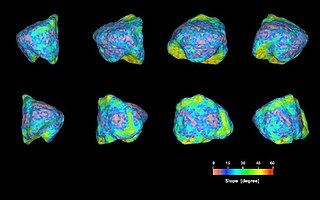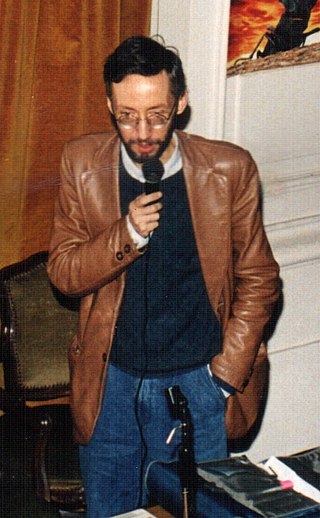
In celestial mechanics, the Lagrange points are points of equilibrium for small-mass objects under the gravitational influence of two massive orbiting bodies. Mathematically, this involves the solution of the restricted three-body problem.

The Yarkovsky effect is a force acting on a rotating body in space caused by the anisotropic emission of thermal photons, which carry momentum. It is usually considered in relation to meteoroids or small asteroids, as its influence is most significant for these bodies.

Phobos is the innermost and larger of the two natural satellites of Mars, the other being Deimos. The two moons were discovered in 1877 by American astronomer Asaph Hall. It is named after Phobos, the Greek god of fear and panic, who is the son of Ares (Mars) and twin brother of Deimos.

Geophysics is a subject of natural science concerned with the physical processes and physical properties of the Earth and its surrounding space environment, and the use of quantitative methods for their analysis. Geophysicists, who usually study geophysics, physics, or one of the Earth sciences at the graduate level, complete investigations across a wide range of scientific disciplines. The term geophysics classically refers to solid earth applications: Earth's shape; its gravitational, magnetic fields, and electromagnetic fields ; its internal structure and composition; its dynamics and their surface expression in plate tectonics, the generation of magmas, volcanism and rock formation. However, modern geophysics organizations and pure scientists use a broader definition that includes the water cycle including snow and ice; fluid dynamics of the oceans and the atmosphere; electricity and magnetism in the ionosphere and magnetosphere and solar-terrestrial physics; and analogous problems associated with the Moon and other planets.

The vulcanoids are a hypothetical population of asteroids that orbit the Sun in a dynamically stable zone inside the orbit of the planet Mercury. They are named after the hypothetical planet Vulcan, which was proposed on the basis of irregularities in Mercury's orbit that were later found to be explained by general relativity. So far, no vulcanoids have been discovered, and it is not yet clear whether any exist.

6489 Golevka is an Apollo, Mars-crosser, and Alinda asteroid discovered in 1991 by Eleanor F. Helin.

The Yarkovsky–O'Keefe–Radzievskii–Paddack effect, or YORP effect for short, changes the rotation state of a small astronomical body – that is, the body's spin rate and the obliquity of its pole(s) – due to the scattering of solar radiation off its surface and the emission of its own thermal radiation.

Planetary geology, alternatively known as astrogeology or exogeology, is a planetary science discipline concerned with the geology of celestial bodies such as planets and their moons, asteroids, comets, and meteorites. Although the geo- prefix typically indicates topics of or relating to Earth, planetary geology is named as such for historical and convenience reasons; due to the types of investigations involved, it is closely linked with Earth-based geology. These investigations are centered around the composition, structure, processes, and history of a celestial body.
99942 Apophis (provisional designation 2004 MN4) is a near-Earth asteroid and a potentially hazardous object with a diameter of 370 metres (1,210 feet) that caused a brief period of concern in December 2004 when initial observations indicated a probability up to 2.7% that it would hit Earth on April 13, 2029. Additional observations provided improved predictions that eliminated the possibility of an impact on Earth in 2029. Until 2006, a small possibility nevertheless remained that, during its 2029 close encounter with Earth, Apophis would pass through a gravitational keyhole of no more than about 800 kilometres (500 mi) in diameter, which would have set up a future impact exactly seven years later on April 13, 2036. This possibility kept it at Level 1 on the Torino impact hazard scale until August 2006, when the probability that Apophis would pass through the keyhole was determined to be very small and Apophis's rating on the Torino scale was lowered to zero. By 2008, the keyhole had been determined to be less than 1 km wide. During the short time when it had been of greatest concern, Apophis set the record for highest rating ever on the Torino scale, reaching level 4 on December 27, 2004.
Jean-Luc Margot is a Belgian-born astronomer and a UCLA professor with expertise in planetary sciences and SETI.

The Lunar and Planetary Laboratory (LPL) is a research center for planetary science located in Tucson, Arizona. It is also a graduate school, constituting the Department of Planetary Sciences at the University of Arizona. LPL is one of the world's largest programs dedicated exclusively to planetary science in a university setting. The Lunar and Planetary Lab collection is held at the University of Arizona Special Collections Library.

There is evidence that the formation of the Solar System began about 4.6 billion years ago with the gravitational collapse of a small part of a giant molecular cloud. Most of the collapsing mass collected in the center, forming the Sun, while the rest flattened into a protoplanetary disk out of which the planets, moons, asteroids, and other small Solar System bodies formed.

Maria T. Zuber is an American geophysicist who is the vice president for research at the Massachusetts Institute of Technology, where she also holds the position of the E. A. Griswold Professor of Geophysics in the Department of Earth, Atmospheric and Planetary Sciences. Zuber has been involved in more than half a dozen NASA planetary missions aimed at mapping the Moon, Mars, Mercury, and several asteroids. She was the principal investigator for the Gravity Recovery and Interior Laboratory (GRAIL) Mission, which was managed by NASA's Jet Propulsion Laboratory.
Thermophysics is the application of thermodynamics to geophysics and to planetary science more broadly. It may also be used to refer to the field of thermodynamic and transport properties.

James F. Bell III is a professor of Astronomy at Arizona State University, specializing in the study of planetary geology, geochemistry and mineralogy using data obtained from telescopes and from various spacecraft missions. Bell's active research has involved the NASA Mars Pathfinder, Near Earth Asteroid Rendezvous (NEAR), Comet Nucleus Tour (CONTOUR), 2001 Mars Odyssey, Mars Reconnaissance Orbiter, Lunar Reconnaissance Orbiter, and the Mars Science Laboratory missions. His book Postcards from Mars includes many images taken by the Mars rovers. Bell is currently an editor of the space science journal Icarus and president of The Planetary Society. He has served as the lead scientist in charge of the Panoramic camera (Pancam) color imaging system on Mars rovers Spirit and Opportunity.

9921 Rubincam, provisional designation 1981 EO18, is a stony asteroid from the inner regions of the asteroid belt, approximately 4 kilometers in diameter. It was discovered on 2 March 1981, by American astronomer Schelte Bus at the Siding Spring Observatory in Australia, and later named after American geophysicist David Rubincam.

Bruce Martin Jakosky is a professor of Geological Sciences and associate director of the Laboratory for Atmospheric and Space Physics (LASP) at the University of Colorado, Boulder. He has been involved with the Viking, Solar Mesosphere Explorer, Clementine, Mars Observer, Mars Global Surveyor, Mars Odyssey, Mars Science Laboratory and MAVEN spacecraft missions, and is involved in planning future spacecraft missions.

Paolo Farinella was an Italian scientist very active in the field of planetary science and in particular in the study of asteroids and small bodies of the Solar System.

Planetary science is the scientific study of planets, celestial bodies and planetary systems and the processes of their formation. It studies objects ranging in size from micrometeoroids to gas giants, aiming to determine their composition, dynamics, formation, interrelations and history. It is a strongly interdisciplinary field, which originally grew from astronomy and Earth science, and now incorporates many disciplines, including planetary geology, cosmochemistry, atmospheric science, physics, oceanography, hydrology, theoretical planetary science, glaciology, and exoplanetology. Allied disciplines include space physics, when concerned with the effects of the Sun on the bodies of the Solar System, and astrobiology.
















